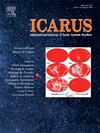在含甲烷的大气中,由于高超声速高温流动而形成和积累的索林
IF 3
2区 物理与天体物理
Q2 ASTRONOMY & ASTROPHYSICS
引用次数: 0
摘要
我们报告了另一种索林形成机制,依赖于高超音速流动中通常可用的高能量。所考虑的条件是车辆或陨石进入含有所需前体分子的大气的代表性条件。结果表明,所涉及的高温可以破坏甲烷分子中的化学键,从而释放出气体混合物中的碳原子。这些物质可以与其他物质结合,根据反应发生的当地条件,形成碳含量不同的各种化合物。值得注意的是,组成的可变性还取决于气体流动中分子所遵循的特定路径。电流中突然膨胀或局部激波的存在以及随之而来的压力和温度变化对有机残留物的性质具有不可忽视的影响。通过一系列化学和光谱技术:大气压光电离质谱(api - ms),元素分析,红外吸收(FT-IR),紫外可见吸收和荧光。此外,还努力将它们与实验所用高超声速风洞中发生的热化学和流体动力学条件联系起来。总的来说,这些结果表明了一种新的可能形成索林的途径,这一途径迄今为止知之甚少,几乎没有研究过。本文章由计算机程序翻译,如有差异,请以英文原文为准。
Tholin formation and accumulation due to hypersonic high-temperature flows in methane-containing atmospheres
We report on another tholins formation mechanism relying on the high energies typically available in hypersonic flows. The considered conditions are representative of vehicle or meteorite entry in atmospheres containing the required precursor molecules. It is shown that the involved high temperatures can break the chemical bonds in methane molecules, thereby releasing carbon atoms in the gas mixture. These can combine with the other species and form various compounds with a variable degree of carbon depending on the local conditions in which the reaction takes place. Notably, the variability in composition also depends on the specific path followed by molecules in the gas flow. The presence of sudden expansions or localized shock waves in the current and the ensuing variations in pressure and temperature, have a non-negligible effect on the nature of the organic residues. These have been characterized by an array of chemical and spectroscopic techniques: atmospheric pressure photoionization mass spectrometry (APPI-MS), elemental analysis, infrared absorption (FT-IR), UV–visible absorption and fluorescence. Moreover, some effort was provided to correlate them with the thermochemical and fluid-dynamic conditions occurring in the hypersonic wind tunnel used for the experiments. Overall, such results suggest a novel possible route to the formation of tholins, which is still poorly known and hitherto scarcely investigated.
求助全文
通过发布文献求助,成功后即可免费获取论文全文。
去求助
来源期刊

Icarus
地学天文-天文与天体物理
CiteScore
6.30
自引率
18.80%
发文量
356
审稿时长
2-4 weeks
期刊介绍:
Icarus is devoted to the publication of original contributions in the field of Solar System studies. Manuscripts reporting the results of new research - observational, experimental, or theoretical - concerning the astronomy, geology, meteorology, physics, chemistry, biology, and other scientific aspects of our Solar System or extrasolar systems are welcome. The journal generally does not publish papers devoted exclusively to the Sun, the Earth, celestial mechanics, meteoritics, or astrophysics. Icarus does not publish papers that provide "improved" versions of Bode''s law, or other numerical relations, without a sound physical basis. Icarus does not publish meeting announcements or general notices. Reviews, historical papers, and manuscripts describing spacecraft instrumentation may be considered, but only with prior approval of the editor. An entire issue of the journal is occasionally devoted to a single subject, usually arising from a conference on the same topic. The language of publication is English. American or British usage is accepted, but not a mixture of these.
 求助内容:
求助内容: 应助结果提醒方式:
应助结果提醒方式:


